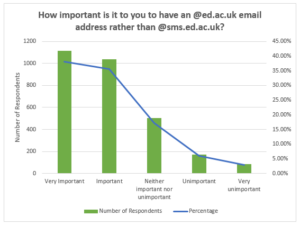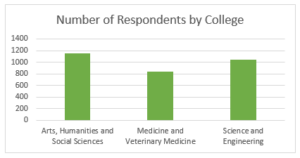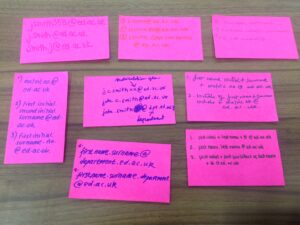Names not Numbers: Students Decide on New Email Address Format
Background
Information Services are updating the format of the student email address, changing it from a format based on matriculation number to a name based format. To help inform our decisions with this change, we have been consulting with students via the means of an online survey and focus groups.
You can hear more about the background to the project, and our focus groups, in our video:
Over 3,000 students responded to our survey, across year groups and across schools. A PDF of the survey questions is available here: Student Email Survey Questions.
We disseminated the survey in as many ways as possible: an announcement on MyEd, tweets, posters and emails via the school offices. The most effective method appeared to be the email from the school offices – it was the first method of communication that we made use of and the majority of respondents answered the survey within the first few days of these emails going out. We also gave respondents the opportunity to enter into a prize draw to win an iPad which no doubt helped with response numbers!
750 students indicated at the end of the survey that they were interested in undertaking further consultation activities with us and responded enthusiastically to our invitation to participate in focus groups. All 35 spaces on the focus groups were filled in less than 48 hours of the invitations being sent out. In the focus groups, we focused on questions where the responses to the survey had not produced a clear-cut consensus, in order to get a better idea of how to approach these. We did some group work and got the students to work together to think through different ideas for the format of the email address as well as having more open discussions.

We can see from this graph of survey responses how important it is to students to have an @ed.ac.uk email address
One of the most unanimous results to emerge from the consultation was that the student body, as a whole, want to get rid of the presence of ‘sms’ in the current email address format and simply have an @ed.ac.uk address. Another clear consensus to emerge was the desire among students to have an alumni email address so they can retain their connection to the university after graduating.
What has been abundantly clear throughout the consultation is that their university email address is something that is very important to students because it links them to the university and forms part of their professional identity. You can view our summary of the survey results
We would like to thank everyone who has helped us make the consultation such a success, including student and staff respondents to the survey, the focus group participants and especially the staff in the school offices who helped us get word out about the survey.
A more in-depth analysis of the consultation results is available here: Final Report on the Student Email Consultation Project
The raw data of the survey results are available here:
Student Survey Results (Additional Questions)
Highlights
- One of the real highlights for us of the consultation was the depth and level of participation from students from across the university. As you will see from looking at the raw data of the survey results, many of the respondents went into a lot of depth with their free-text comments, reflecting how important their university email address is to them.
- We also received responses from across the protected characteristics of the Equality Act which was very important to us in terms of representing as many in the student body as possible.
- The level of engagement in the focus groups was also very impressive, with participants requiring minimal prompting from the facilitator to discuss their opinions.
- 100% of the focus group participants said in the feedback forms that they thought ‘a focus group is a good way of consulting with students’ and ‘I would participate in another focus group’. Several also commented that they were very glad to have the opportunity to be listened to by IS staff in such a manner.
- We also received valuable information from respondents on issues not directly related to the email address format.
Lowlights
- The answers to some of the questions in the survey were not as clear-cut as we would have liked them to be. However, we resolved this by focusing on these questions in the focus groups, and from there it was fairly easy to detect a consensus.
- One week after the survey went live, we decided to add in a couple of new questions and we did not receive as many responses in the second week as we did in the first week.
- The volume and quality of the free-text responses mean that the raw data of the responses is more than 200 pages and thus took a long time to read through and analyse.





